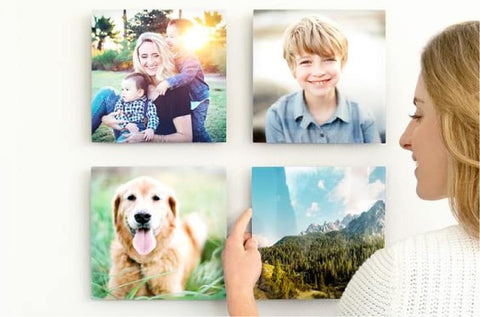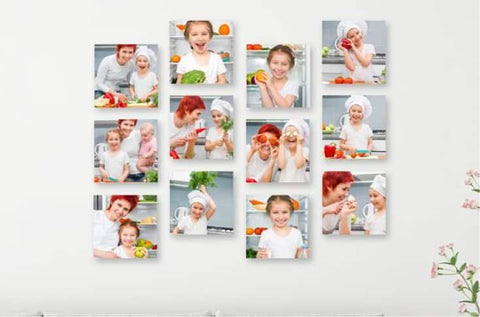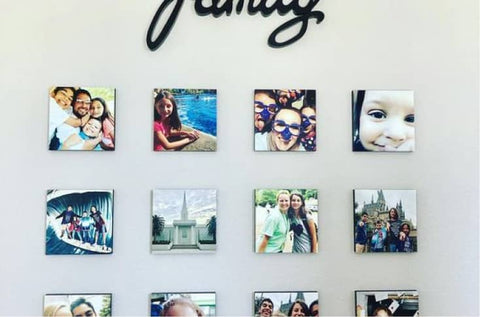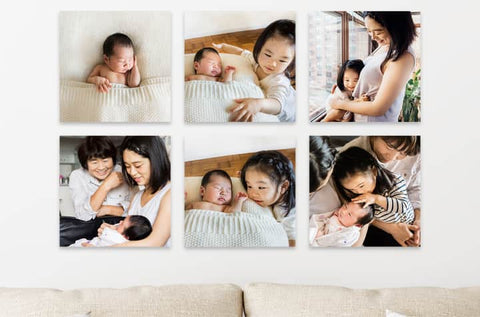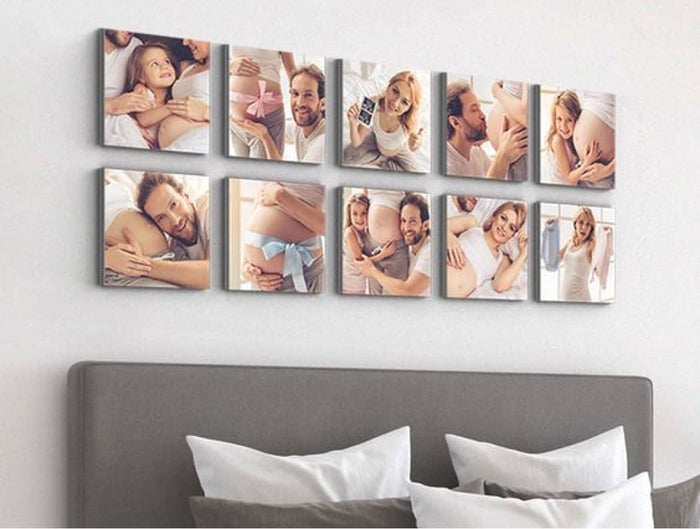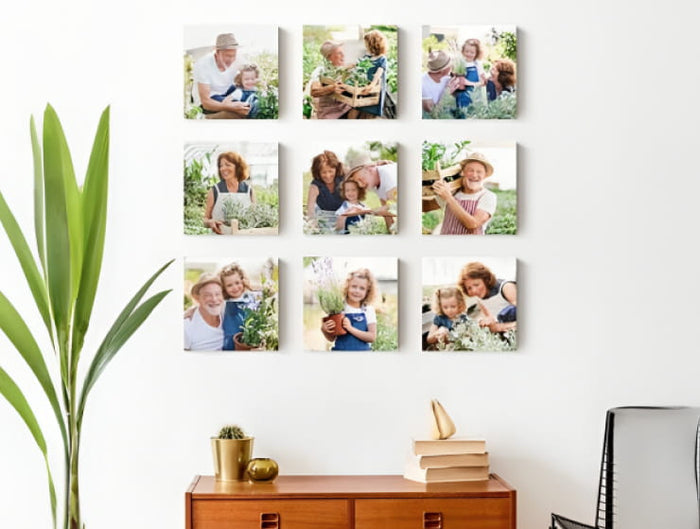Transform Your Space: The Ultimate Guide to Wall Photos
Decorating with wall photos has never been more exciting. From family snapshots to iconic landmarks, transforming your blank walls into personal galleries can bring warmth, character, and creativity into your home. Whether you’re decorating a living room, bedroom, office, or even a public space, a photo wall allows you to tell your story, display your favorite memories, and make a bold design statement. This guide will walk you through everything you need to know about creating wall art from photos, including inspiration, tips, and techniques for achieving a polished, professional look.
Choosing the Perfect Spot for Wall Photos
Selecting the right spot for your wall photo display is the foundation of any successful home or office decor project. The placement of your photos can completely transform a room, turning blank walls into compelling visual statements that tell your story. Before even considering frames, prints, or canvases, it is important to think about where your wall photos will make the greatest impact. Location is not just about aesthetics; it also affects functionality, visibility, and the overall flow of the space. Different rooms serve different purposes, and your photo arrangement should complement that. Living rooms, for instance, are often the social hub of a home, so wall photos in this space should be inviting and spark conversation.
Clustering gallery wall family photos above a sofa or near a coffee table can create a natural focal point where the eyes of guests are immediately drawn. In dining areas, photos can be a subtle conversation starter without overwhelming the space, so a smaller, carefully curated display or a single statement piece can be very effective. Bedrooms, on the other hand, are personal sanctuaries, and photos in these spaces should reflect intimacy and comfort. A gallery of serene landscapes, personal memories, or travel snapshots above the bed or along a wall you face when you wake can create a cozy atmosphere.
Even smaller touches, such as a trio of framed photos or a mini collage on a bedside table wall, can personalize the room without making it feel cluttered. Offices and workspaces also benefit from thoughtful placement. Personalized wall displays in an office, classroom, or studio can help spark creativity, make the space feel welcoming, and remind you of your values and goals. Inspirational images, team photos, or travel memories can all be strategically placed where they catch your eye during the workday, providing a boost of motivation or calm.
The dimensions of your wall should guide your choices as well. Large, open walls are ideal for bold, dramatic gallery walls incorporating multiple frames of varying sizes. Mixing family portraits, travel photographs, or artistic prints can create an eclectic and eye-catching arrangement. Tall walls are perfect for vertical arrangements, while long horizontal walls work well with panoramic layouts or a series of medium-sized photos aligned in a row. Smaller walls, corners, or narrow spaces require a more subtle approach. Mini displays, single statement pieces, or a small series of photographs can have a big impact without overwhelming the space. Hallways and staircases, in particular, are great opportunities to create a visual journey with smaller frames arranged in a linear or staggered pattern. Staircase walls offer a dynamic canvas, allowing the viewer to experience the display as they move from one level to another.
Another key consideration is the height at which you hang your photos. Ideally, the center of a photo should be at eye level, which is typically between 57 and 60 inches from the floor, depending on the average height of the people in your household and the room layout. This ensures your display is both visually appealing and easy to engage with. For gallery walls with multiple frames, keeping the center line at eye level and working outward with frames of different sizes helps create a balanced, intentional composition. Think about who will most frequently view the display—family members, guests, or clients—and adjust accordingly. In hallways or staircases, eye-level placement may vary, so visualizing the natural viewing angles and flow of movement in the space can be very helpful.
Lighting plays an equally important role. Natural light is ideal for showcasing vibrant colors, but direct sunlight can cause fading over time. Consider spots near windows for soft, diffused lighting, or add dedicated picture lights to highlight your favorite photos. In darker areas, strategically placed lamps or LED strips can illuminate your display without overpowering it. Reflective surfaces, such as glossy frames or glass-covered prints, may produce glare under certain lighting conditions, so it is advisable to test your chosen spot at different times of the day. Adjustable lighting can also create dramatic effects in offices or galleries, making photos pop and enhancing the overall aesthetic of the room.
It is also worth thinking beyond traditional walls. Corner walls, above shelves, stairwell walls, or even kitchen backsplashes can serve as creative gallery spaces. Leaning framed photos against a wall on a mantel or shelf allows for flexibility and seasonal updates, while small niches or alcoves are perfect for single statement pieces or layered arrangements. Outdoor or semi-outdoor spaces, such as patios or covered porches, can also become unexpected galleries if weatherproofed prints or frames are used. Creative layouts, including asymmetrical displays or vertical columns of photos, can draw attention and make a space feel curated and intentional.
Ultimately, the perfect spot is one that reflects your personal style and lifestyle. Consider what message you want your wall to convey—is it warmth and nostalgia, adventure and travel, or art and sophistication? Your answers will guide not only where to place your photos but also how to arrange them, which frames to choose, and what images to select. For those who enjoy changing displays frequently, modular arrangements where photos can be rotated or swapped seasonally are a practical option, especially in offices, classrooms, or rental properties.
Choosing the perfect spot for wall photos is a careful blend of art and planning. By considering the purpose of the room, the size and shape of the wall, eye-level placement, lighting, and personal style, you can turn any blank surface into a captivating display. Whether creating dramatic gallery walls in living rooms, intimate arrangements in bedrooms, or inspiring displays in offices and classrooms, the right placement ensures your photos are not just decoration but a visual story that enhances the environment and reflects who you are. The best wall photo displays feel intentional, harmonious, and inspiring every time you look at them, making the simple act of walking into a room a moment of personal connection and enjoyment.
Selecting Your Images for Wall Art
Selecting the right images for your wall art is an essential step in creating a display that is both visually compelling and deeply personal. When it comes to choosing wall photos, diversity, storytelling, and intentionality are key. Rather than relying solely on one type of photograph, mixing different kinds of images can create a sense of depth and visual interest that captures attention. Family photos on canvas provide warmth and personal connection, while travel snapshots can introduce color, texture, and a sense of adventure. Incorporating artwork, whether in the form of prints, sketches, or illustrations, adds another layer of sophistication, while inspirational quotes or typographic prints can provide motivation and thought-provoking focal points. This combination not only keeps a viewer engaged but also ensures that each glance at your wall art reveals something new. A cohesive theme or narrative can help unify the display, whether it centers around family milestones, memorable vacations, or moments of personal achievement.
One popular approach is creating themed photo walls that tell a story. A vacation-themed wall could feature snapshots of famous landmarks, scenic vistas, or candid moments from your travels, while a milestone wall might document birthdays, weddings, graduations, or other significant life events. These arrangements not only preserve memories but also allow them to be celebrated and shared in an aesthetically pleasing format. Black and white photos for wall are another timeless choice, offering elegance and versatility. Their muted tones allow them to harmonize with other artwork and photographs while creating a classic, sophisticated feel. Black and white images work particularly well when paired with colorful prints or when used to highlight historic or emotional moments, creating a striking contrast that draws the eye.
For those who wish to bring a sense of history or cultural significance into their wall displays, including iconic or historic images can be particularly impactful. Berlin wall historical photos, for example, tell stories of resilience and change, evoking reflection and conversation. Similarly, wall street photos or greenwood rising black wall st history center photos capture moments of economic, social, and cultural importance, providing context and grounding your gallery wall in real-world narratives. These kinds of images can serve as both decorative elements and conversation starters, inviting viewers to engage with history and learn through your curated display. Including a mix of modern and historic imagery allows your wall art to communicate across time periods, creating layers of meaning that make your display uniquely yours.
Adventure and nature photography can further enrich your wall art by bringing the outdoors inside. Stunning images such as antarctica ice wall photos, wall doxey state park photos, or landscapes from remote locations provide a sense of scale, wonder, and exploration. These images can evoke feelings of awe and curiosity, reminding viewers of the vastness and beauty of the world beyond their immediate environment. Combining these scenic photos with more personal or intimate images, such as family moments or candid lifestyle shots, creates a dynamic balance between public experience and private memory. The contrast between large sweeping landscapes and small, detailed personal photographs adds visual interest and keeps the eye moving across the wall.
When selecting images, it’s important to consider not just the subject matter but also the format, size, and material of the prints. Canvas photos for wall can give depth and texture, while glossy or matte prints offer different reflective qualities that influence how the images interact with light. Larger prints can serve as anchor pieces for a gallery wall, commanding attention and setting the tone for smaller surrounding images. Smaller prints or collages can fill gaps, add intricacy, and provide opportunities for playful arrangement. Print quality also matters, as high-resolution images maintain clarity and vibrancy, ensuring that every detail is visible and engaging. Mixing materials such as acrylic, metal, or wood-mounted photos alongside traditional paper prints can introduce texture and sophistication to your wall display.
Consider creating a mix of personal, iconic, and scenic images to tell a comprehensive story on your wall. Personal images, such as family portraits, candid moments, and life milestones, make the space uniquely yours. Iconic or historic photos, like wall street photos or berlin wall historical photos, connect your display to broader cultural or historical narratives. Scenic or adventurous images, including antarctica ice wall photos or wall doxey state park photos, provide a sense of movement and exploration. Together, these elements create a gallery that is visually rich, emotionally resonant, and intellectually stimulating. You can also include abstract or artistic elements, such as wall art for photos or typography prints, to add an extra layer of creativity and design flair.
Finally, keep in mind that your wall display is a living piece of art. Over time, you may wish to swap in new photos, rotate seasonal images, or incorporate additional artwork. Flexibility in your selection allows your wall to evolve with your life, capturing ongoing experiences, travels, and achievements. Whether you are curating a gallery wall with multiple framed prints, turning photos into wall art on canvas, or simply creating a thoughtful arrangement of images for a corner wall, the careful selection of photos ensures that your display is cohesive, meaningful, and visually striking. Thoughtful curation of your images transforms a simple collection of photos into a narrative-rich, immersive wall experience that draws the viewer in, tells a story, and creates lasting impact.
Types of Photo Displays
When it comes to decorating your walls with photos, there is a wide array of display options that allow you to turn ordinary snapshots into extraordinary pieces of wall art. The choice of display can dramatically influence the overall aesthetic of your space, so it’s worth considering not only the images themselves but also the medium in which they are presented. One of the most popular options is canvas photos for wall, a classic and versatile choice. Canvas prints add a tactile dimension to your photos, creating a sense of depth and texture that draws the eye. They have a timeless appeal, working well in both modern and traditional interiors, and they can be scaled up or down depending on the size of the wall you are decorating. Larger canvas pieces can serve as anchor points for a gallery wall, while smaller canvases can be clustered together for a dynamic and intimate display.
Glass photos for wall are another striking option, ideal for spaces that call for a sleek, contemporary look. The reflective quality of glass adds a subtle shine, giving images a polished and professional finish. Glass prints are particularly effective for vibrant or high-contrast photographs, as the material enhances color saturation and creates a luminous effect. They can be used as standalone statement pieces or as part of a larger ensemble of wall art photos. Because glass has a modern feel, it pairs beautifully with minimalistic décor, metallic accents, and clean lines, making it a popular choice for offices, living rooms, and galleries.
Acrylic or aluminium prints offer yet another dimension of sophistication. These types of photo displays provide a high-quality, museum-like finish that elevates even casual snapshots into refined artwork. Acrylic prints give images a glossy, almost three-dimensional appearance, while aluminium prints offer durability and a sleek metallic finish. Both options are ideal for photographs with vivid colors or sharp details, as they preserve clarity and brightness over time. Using acrylic or aluminium prints on your wall allows you to experiment with modern, high-end aesthetics without compromising on the personal touch that photographs provide. They are also highly versatile, working well in both residential and commercial spaces.
Framed photos for wall are a more traditional approach, but their versatility cannot be overstated. Frames allow you to combine photos of different sizes, orientations, and subjects while creating a cohesive, polished appearance. You can mix and match frame styles—wood, metal, or painted finishes—to complement the surrounding décor. Framed photos are particularly useful when creating gallery walls, as they help tie together diverse images into a unified visual story. Whether you are displaying family photos on wall, historic imagery, or travel snapshots, frames provide a structure that can make even a highly eclectic mix look intentional and curated.
Tile photos for wall offer a unique and practical option, especially in spaces like bathrooms or kitchens. Tiles provide a durable surface that can withstand moisture and temperature changes while still displaying your images beautifully. They allow for creative layouts, such as grid patterns or mosaic designs, and can be used to create a striking focal point in smaller areas that might otherwise go unnoticed. For example, a small kitchen backsplash featuring tile photos can become an artistic centerpiece that adds personality and charm.
For those seeking truly unique flair, a collage of photos on wall is an excellent way to showcase multiple images in a single cohesive display. Collages allow for layering, overlapping, and creative arrangements that can highlight relationships between different photos, whether they are family portraits, vacation memories, or snapshots of everyday life. Wall art photos that mix textures and materials, such as combining canvas, glass, and acrylic prints, can add visual depth and interest. This approach encourages experimentation, letting you create a gallery wall that is uniquely yours.
Printed photos for wall, wall prints from photos, or large wall prints from photos can also make a dramatic statement. Larger pieces can serve as the centerpiece of a room, drawing attention and anchoring surrounding décor. Whether you opt for oversized prints above a sofa, in a hallway, or in a bedroom, the impact of large-scale photography is undeniable. These displays allow you to celebrate a single image or highlight a particularly meaningful memory in a way that smaller prints simply cannot match.
Beyond the choice of material or size, the way you arrange these displays also matters. Combining different types of displays—such as a framed photo surrounded by smaller tile prints or acrylic pieces—creates dynamic wall art that engages the eye. You can also play with themes, color palettes, or photographic styles, such as mixing black and white photos for wall with colorful vacation snapshots, to give your display a cohesive yet varied appearance. The flexibility of these display options ensures that every space, no matter its size or style, can be transformed into a personalized and visually appealing gallery of memories.
How to Arrange Photos on Wall
Arranging photos on a wall is both an art and a science, and taking the time to plan your layout can dramatically elevate your wall display. The way images are positioned can affect the overall balance, visual interest, and storytelling potential of your wall, making it an essential step in creating a compelling gallery. One of the most effective ways to start is by laying all your photos on the floor before committing anything to the wall. This allows you to experiment freely, shuffle pieces around, and see how different sizes, orientations, and frames interact with each other without making permanent decisions. You can group photos by theme, color palette, or subject matter, or you can deliberately mix styles to create a dynamic, eclectic display.
When arranging photos, it is important to think about balance and proportion. Large pieces can act as anchors in your layout, drawing the eye and providing a foundation around which smaller photos can be placed. These anchor pieces are often statement prints or family photos on wall that hold special significance, and they help create a visual hierarchy that guides the viewer’s attention. Smaller photos, on the other hand, are excellent for filling gaps and adding texture to the composition. By alternating vertical and horizontal orientations, you create variety, prevent monotony, and maintain a sense of movement throughout the display. It’s also a good idea to alternate shapes and frame styles. Combining square, rectangular, and even circular frames adds an element of surprise, while mixing materials such as canvas, glass, or tile photos for wall introduces depth and tactile interest.
A creative approach to arranging photos is to incorporate objects alongside images. Mirrors, shelves, or even small wall sculptures can be integrated to make a gallery wall with mirror and photos, adding reflective surfaces and breaking up visual density. For example, a central mirror surrounded by framed photos can serve as both a functional and decorative feature, while shelves interspersed with smaller photo frames allow for three-dimensional layering. This type of arrangement works particularly well in living rooms, hallways, or entryways, where visual interest at multiple levels makes the space feel thoughtfully curated and lively.
When planning your arrangement, it is helpful to consider the flow and movement of the eye. Asymmetrical layouts can convey energy and spontaneity, making them ideal for casual or creative spaces, whereas symmetrical arrangements provide a sense of harmony and order, which works well in more formal areas such as offices or dining rooms. Asymmetrical layouts can also be effective for gallery walls with family photos, where you want each piece to stand out individually while contributing to a cohesive overall story. Symmetry, on the other hand, creates balance by ensuring that similar elements are evenly distributed across the display, giving the viewer a satisfying sense of structure.
Thinking beyond flat wall surfaces can unlock new opportunities for displaying images. Corner wall photos, for example, make use of often-overlooked spaces, transforming corners into visually interesting and immersive areas. You can wrap photos around corners, gradually transitioning from larger prints on one wall to smaller images on the adjoining surface, creating a flow that encourages viewers to explore the entire space. Similarly, staircases offer a natural diagonal line that can be followed when hanging photos on wall. Arranging images along the incline of a staircase can highlight memorable trips, family milestones, or abstract compositions in a way that feels integrated with the architecture.
Another helpful strategy is to use paper templates or cutouts of your frames to visualize the arrangement on the wall before committing to nails or hooks. Tape these cutouts to the wall to test spacing, alignment, and overall composition. This method is especially useful for larger arrangements or gallery walls that include multiple frame types, tile photos for wall, or prints in different materials. It allows you to make adjustments without damaging the wall or overthinking spacing, ensuring a polished, professional-looking result.
Spacing between photos is equally important. While there is no hard rule, maintaining consistent gaps creates cohesion, whereas uneven spacing can introduce visual tension. A general guideline is to leave about 2 to 5 inches between frames, but this can vary based on the size of the photos and the overall scale of the wall. Mixing larger and smaller pieces helps balance the spacing, and using vertical and horizontal orientations in tandem keeps the arrangement dynamic. Over time, you may also choose to rotate images or add new photos to keep the display fresh and reflective of your evolving experiences.
In addition to physical arrangement, consider the narrative that your wall tells. A thoughtfully curated selection of images—such as berlin wall photos alongside family travel snapshots or wall street photos mixed with gallery wall family photos—can communicate a story, celebrate achievements, or commemorate milestones. You can create a chronological journey, a thematic display, or even a color-coordinated gallery, depending on your vision. This approach ensures that your wall is not just decorative but also meaningful, connecting viewers to your personal experiences and memories.
Lighting also plays a subtle yet important role in arranging photos. Natural light can enhance colors and textures, while well-placed wall lights or picture lights can highlight key pieces. Adjusting lighting angles prevents glare on glass photos for wall and adds depth to canvas or acrylic prints, further enhancing the overall visual impact. By combining thoughtful layout, balance, and lighting, you can transform an ordinary wall into a captivating focal point that reflects your personality and style while showcasing your most cherished memories.
Hanging Photos on Wall
Knowing how to hang photos on wall is a fundamental step in creating a polished and professional-looking display, whether it’s in a living room, bedroom, hallway, or even a small nook. The first consideration is the type of wall and the weight of the photo or print. Heavier pieces, such as canvas wall prints from photos or large framed photos for wall, require sturdy hardware like wall anchors, screws, or specialized picture hooks designed to support their weight. Using the proper hardware not only ensures that your photos stay securely in place but also prevents accidental damage to both your wall and the artwork itself. For lighter pieces, such as small canvas photos for wall or printed photos for wall, nails, adhesive strips, or hook-and-loop fasteners can be sufficient, offering flexibility and ease of repositioning without leaving permanent holes.
Leveling your frames is equally important. Even slightly crooked photos can make a display appear cluttered or unorganized, regardless of how beautifully the frames or photos themselves are curated. A simple level tool can ensure that each frame hangs straight, and for a multi-photo arrangement, consider a laser level to maintain consistent alignment across the wall. Taking the time to measure spacing between frames and ensuring uniformity in rows or clusters can make the difference between a casual collage and a refined gallery wall photos arrangement. For casual or eclectic displays, however, a slightly staggered or asymmetrical placement can feel intentional and lively, adding personality without appearing sloppy.
For those new to hanging multiple photos, one highly effective approach is to use templates or paper cutouts. By cutting out the size of each frame from paper and taping these cutouts to the wall, you can experiment with layout, spacing, and arrangement before committing to nails or hooks. This technique allows you to see how frames interact with one another and helps prevent unnecessary holes in your wall. It is especially useful for gallery wall family photos, collage of photos on wall, or even more complex arrangements that include a mix of canvas, glass photos for wall, and framed prints. This method is also perfect for corner wall photos or spaces where the wall surface is uneven or irregular, ensuring a well-balanced display from multiple angles.
Small spaces present a unique challenge when hanging photos on wall, but they also offer opportunities for creative solutions. Shelves, mantels, or built-in nooks allow photos to be leaned rather than hung, creating a relaxed and versatile display. This approach works particularly well for bathroom photos for wall, hole in the wall flatiron photos, or wall drug photos, where wall space may be limited or the environment may not be suitable for permanent hardware. Leaning photos on shelves also enables layering, allowing you to place smaller prints in front of larger ones, mix in decorative objects, or rotate pieces seasonally without committing to a fixed arrangement.
When dealing with a series of photos or prints, spacing is a key consideration. Maintaining a consistent gap between images creates visual coherence, while varying the space slightly can add a sense of movement and dynamic interest. A common rule of thumb is to leave between two to five inches of space, depending on the size of the frames and the overall composition. Larger pieces benefit from more breathing room, while smaller prints or collage of photos on wall can be clustered more tightly to maintain focus. When planning spacing, also consider the height at which photos are displayed. Eye level is generally the most appealing and comfortable for viewers, typically around 57 to 60 inches from the floor to the center of a piece, though this may vary depending on ceiling height and furniture placement.
For multi-photo displays, mixing different orientations, sizes, and frame types creates visual interest and can highlight individual pieces without making the wall feel chaotic. Vertical and horizontal photos can be alternated, large anchor pieces can balance smaller prints, and a combination of materials such as acrylic, canvas, and glass adds texture. Even integrating other elements, like mirrors or wall-mounted shelves, can enhance depth and provide a three-dimensional effect. A gallery wall with mirror and photos, for example, becomes not just a display of images but a curated artistic statement.
Lighting is another often-overlooked aspect of hanging photos on wall. Proper illumination ensures that your photos are seen in their best light, enhancing colors, contrasts, and details. Natural light can be flattering, but avoid direct sunlight, which may fade prints over time. Adjustable picture lights or wall-mounted lamps allow you to direct attention to key pieces, such as a large canvas wall print from photos or a series of historical prints like berlin wall photos or greenwood rising black wall st history center photos. Strategically placed lighting can create focal points, highlight textures, and even cast subtle shadows that add dimension to the display.
Beyond standard walls, photos can also be creatively positioned on unconventional surfaces. For instance, leaning framed photos for wall against mantels, window sills, or even against the backs of furniture can give a casual, gallery-inspired look. Displaying wall drug photos on a floating shelf with small decorative objects or using a collage of photos on wall in a corner nook can transform overlooked spaces into areas of visual interest. Similarly, spaces like hole in the wall flatiron photos or the wall street bar and grill photos can benefit from thoughtfully hung photos that tell a story while adding warmth and character.
Finally, personal expression is at the heart of successfully hanging photos on wall. Whether you are arranging gallery wall family photos in a living room, leaning bathroom photos for wall, or curating a display of wall drug photos, each choice reflects your taste, memories, and personality. By combining careful measurement, creative placement, and thoughtful selection of materials, you can ensure that your photos not only enhance the aesthetic of the space but also capture attention and spark conversation. A well-executed photo wall, after all, is both an artistic statement and a personal narrative, transforming walls from mere surfaces into visual storytelling canvases that resonate with anyone who encounters them.
Creative Themes for Wall Photos
Creating a photo wall can be a deeply personal and creative endeavor, and selecting a theme can be one of the most effective ways to tie the display together. Themes help unify disparate images and provide a narrative or visual coherence that draws the eye and creates a sense of purpose. Travel memories are one of the most popular and versatile themes, offering endless possibilities for vibrant and engaging displays. Imagine a wall dedicated to your favorite trips, featuring a mixture of great wall of china photos, great wall cuisine photos, and great wall restaurant photos. These images not only capture memorable experiences but also create a dynamic collage that transports viewers to the locations you cherish. Incorporating travel-related items such as maps, postcards, or small souvenirs alongside the photos can add depth and texture, making the wall both visually appealing and meaningful.
Historic and cultural moments also lend themselves beautifully to themed wall photo displays. By selecting images that document significant events, periods, or cultural landmarks, you create a visual narrative that engages viewers intellectually and emotionally. Berlin wall photos, new black wall street market photos, and berlin wall historical photos are examples of images that carry historical weight and storytelling power. Combining these with carefully chosen frame styles and arrangements can transform a blank wall into an educational and thought-provoking gallery. For those interested in history, blending archival prints with modern interpretations, such as photos of contemporary street art or cultural festivals in historically significant areas, can make the display feel both relevant and timeless.
Food and dining experiences offer yet another imaginative theme for wall photos, appealing to the senses and memories of flavor and social connection. Photos from family meals, restaurant outings, or culinary adventures can be compiled into a cohesive display that captures the joy of eating and gathering. Examples such as great wall super buffet photos, shoprite of wall township photos, or battista's hole in the wall photos provide snapshots of unique dining experiences that evoke nostalgia and delight. Arranging these images with attention to color, lighting, and spacing can make the wall feel lively and inviting, almost as if viewers can taste the dishes simply by looking at the pictures. For an added touch, small shelves with related mementos, such as menus, recipe cards, or miniature kitchenware, can enhance the thematic connection and create a multi-dimensional display.
Iconic landmarks form another compelling theme for wall photos, particularly for those who love architecture, history, or world travel. Showcasing images of well-known sites allows you to celebrate human achievement and natural beauty while providing viewers with a visual journey around the globe. Wall stadium photos, the great wall of los angeles photos, or wall street bath & spa 88 photos, for instance, offer striking visual focal points that can anchor a display. Combining wide-angle shots with detailed close-ups allows for a more engaging experience, as viewers can appreciate both the scale and intricate details of each landmark. Additionally, mixing in candid street scenes or local cultural moments associated with each landmark can enrich the storytelling aspect and give the display a sense of place and atmosphere.
In addition to thematic content, attention to color and style is essential for creating a cohesive and polished photo wall. Choosing a consistent color palette can transform a collection of unrelated images into a unified visual composition. Black and white photos for wall are particularly effective for historical, architectural, or artistic themes, providing a timeless and sophisticated look. For travel or food-themed walls, matching tones—such as warm earthy colors, vibrant saturated hues, or muted pastels—can create harmony and ensure that no single image feels out of place. Beyond color, exploring variations in finish can also elevate the display. Matte or glossy photos for wall each offer different visual effects, with matte providing a soft, understated elegance and glossy enhancing vibrancy and depth. Photos that stick to wall, whether through removable adhesives, magnetic frames, or innovative mounting solutions, allow for flexibility and experimentation, enabling you to rearrange or update your display over time without damaging the wall surface.
Another way to enhance thematic cohesion is through the use of aesthetic photos for wall that adhere to a particular mood, style, or visual motif. For example, travel walls can benefit from sun-drenched landscapes, architectural lines, or candid cultural moments, while food walls might focus on texture, color, and presentation. Combining thematic images with complementary design elements such as frames, mats, or wall decals can reinforce the overall concept. For instance, using minimalist black frames for a historic or architectural theme creates a clean, gallery-like appearance, whereas rustic wooden frames for a travel or food theme evoke warmth and charm.
Experimenting with arrangement is also key to maximizing the impact of themed wall photos. Large anchor images can be surrounded by smaller prints to create visual balance and rhythm. Alternating vertical and horizontal orientations, layering some images slightly over others, or integrating decorative objects such as mirrors, clocks, or small shelves can add depth and dimension. Even seemingly minor details, like the distance between photos or the alignment relative to furniture, can significantly influence the overall effect. For example, placing a series of great wall cuisine photos at eye level on a kitchen or dining room wall allows them to be appreciated in context, while wall stadium photos might be arranged in a more dramatic, larger-scale display for a living room or hallway gallery.
Ultimately, the beauty of themed wall photos lies in their ability to tell a story. Each image contributes to a broader narrative, whether that story is about personal experiences, historical moments, culinary adventures, or architectural achievements. Themes provide structure while allowing for individual creativity, making it possible to curate a wall that is not only visually striking but also meaningful. By thoughtfully selecting images, considering color palettes and finishes, experimenting with arrangement, and integrating complementary elements, any wall can be transformed from a blank surface into a cohesive and compelling visual statement. A well-executed themed photo wall captures attention, sparks conversation, and provides ongoing enjoyment for anyone who encounters it, reflecting both your personal taste and the stories you wish to share with the world.
Transforming Your Wall Photos into Art
Transforming your wall photos into art is one of the most exciting ways to elevate your home decor. The beauty of this process is that it allows you to showcase personal memories while simultaneously turning them into visually captivating pieces that feel gallery-worthy. One of the most popular methods is using canvas wall prints from photos. Canvas offers a rich texture and depth that immediately adds warmth and sophistication to a room. Unlike traditional prints, canvas can make your images feel like a true piece of art, whether it’s a family portrait, a travel snapshot, or even aesthetic photos for wall inspired by nature or abstract patterns. By experimenting with sizes, from small statement pieces to large wall prints from photos, you can create a dynamic focal point that draws attention and sets the tone for the entire space.
Wall art from photos is another versatile approach that allows for creative expression. With this method, you can mix and match materials, such as combining printed photos for wall with glass photos for wall or acrylic pieces, to produce a multi-dimensional display. For instance, layering textures or integrating metallic finishes can give a contemporary edge, while maintaining the personal significance of each photo. Even incorporating elements like mirrors or wall tiles photos can add intrigue and visual interest, making your display more than just a collection of images—it becomes a thoughtful and artistic narrative. Turning photos into wall art in this way encourages experimentation with placement, orientation, and scale, helping to create a truly one-of-a-kind gallery.
For those who want to push creativity further, photos into wall art can be transformed in ways that mimic painting or mixed media styles. This can involve enlarging photos for wall art to emphasize details, textures, and colors that might otherwise go unnoticed. Large wall prints from photos make bold statements, perfect for living rooms, hallways, or feature walls, while smaller collage of photos on wall allows you to highlight multiple memories in a cohesive arrangement. Collages are particularly effective for storytelling, as they can feature chronological family photos on wall, travel highlights, or themed series, offering a visually compelling journey that invites viewers to linger.
Experimentation is key when turning photos into wall art. Consider mixing traditional framed photos for wall with canvas wall prints from photos, wall art photos, and even printed photos for wall in unique configurations. Some people opt for geometric arrangements, while others embrace asymmetrical layouts that feel spontaneous and modern. You can also explore black and white photos for wall or matte or glossy photos for wall depending on the mood you wish to convey. Matte finishes often lend a sophisticated, understated look, while glossy prints bring vibrancy and light to your images, enhancing colors and details.
Ultimately, the goal is to create a display that is personal, engaging, and visually appealing. By experimenting with canvas wall prints from photos, wall art from photos, and photos into wall art, you can turn your memories into something far greater than simple snapshots. Each piece becomes a statement, a story, and a reflection of your style, all while transforming ordinary walls into extraordinary visual experiences. Whether you prefer a subtle, cohesive display or bold, eclectic compositions, the possibilities are endless, limited only by your imagination and the stories you wish to tell through your images.
Unique Wall Photo Ideas
Unique wall photo ideas can transform a plain wall into a vibrant and personalized gallery, giving your space character and a sense of storytelling. One of the most engaging approaches is to create storyboards or themed walls. By focusing on a specific narrative or idea, you can guide viewers through a visual journey. For instance, displaying lifetime memories alongside one wall street photos, hyatt centric wall street New York photos, or one wall street photos can create a sophisticated, urban-themed storyboard. You might pair images from trips, important milestones, or significant events with artistic cityscapes or historic photographs, forming a cohesive story that feels intentional and curated. Themed walls are not limited to cityscapes—they can revolve around travel adventures, family milestones, hobbies, or even favorite quotes. Choosing a theme gives your display structure while allowing creativity to flourish within defined boundaries.
Interactive spaces are another way to make wall photos unique. Instead of a traditional, static arrangement, consider designs that invite engagement and exploration. Adding wall art photos, wall frames for photos, or gallery wall photos with small interactive elements—like spaces for guests to add Polaroids, sticky notes, or personal messages—creates a dynamic display that evolves over time. This type of wall works particularly well in shared spaces such as living rooms, offices, or even classrooms, where interaction fosters connection and encourages people to take a closer look. You can also integrate elements like small shelves, clipboards, or magnetic strips to allow rotating photos, making the wall a living and ever-changing feature.
Pop culture inspiration can add a fun and playful dimension to your wall photo collection. Images such as Vans off the wall skatepark photos, off the wall Kendall photos, or Paul Smith pink wall photos provide vibrant colors, recognizable references, and a modern edge that appeals to both kids and adults. Pop culture displays are perfect for bedrooms, entertainment rooms, or creative spaces, where the wall becomes a reflection of personality and contemporary interests. Mixing pop culture pieces with more personal images can create a balance between whimsy and sentimentality, making the wall engaging yet meaningful.
Hunting for hidden gems is another creative strategy. Photos of hole in the wall saloon photos, hole in the wall – Flatiron photos, or Delaney's hole in the wall photos capture unique, lesser-known places that can spark curiosity and conversation. Including these distinctive images alongside family photos or travel shots can give your wall a sense of adventure and discovery. Hidden gem photos are excellent for creating a visually eclectic display that feels like a journey through special, off-the-beaten-path locations, adding depth and intrigue to your arrangement.
For a cozy and intimate vibe, combine family photos on wall with wall of love photos and wall art for photos. Layering personal images with artistic pieces can create warmth, nostalgia, and emotional resonance, turning your wall into a space that is uniquely yours. Mixing textures, frame styles, and photo sizes enhances visual interest while maintaining a comfortable and inviting atmosphere. Adding personal touches like small memorabilia, tickets, or handwritten notes further enriches the display, making the wall more than just decoration—it becomes a canvas of memories, stories, and personality.
By exploring storyboards, interactive displays, pop culture inspirations, hidden gems, and cozy family arrangements, you can create wall photo projects that are entirely unique. These ideas encourage creativity, personalization, and engagement, transforming ordinary walls into memorable and expressive spaces that reflect who you are and what matters most to you.
Creative Wall Photo Layouts
Creative wall photo layouts are an essential part of designing a visually engaging display. The arrangement of your photos can dramatically change the perception of a space, making it feel more organized, dynamic, or playful depending on your approach. One of the most classic options is a symmetrical layout. Symmetry offers balance and harmony, making it ideal for structured gallery wall photos or formal areas like living rooms and dining rooms. In this arrangement, frames are evenly spaced, and visual weight is distributed equally on both sides, creating a cohesive and polished look. Symmetrical layouts are particularly effective when working with uniform frames or consistent photo sizes, as they reinforce the sense of order and elegance.
Asymmetrical layouts, on the other hand, bring a lively and energetic quality to your wall display. By intentionally mixing frame sizes, shapes, and orientations, you create visual movement that guides the viewer’s eye naturally across the wall. This approach works well for gallery wall family photos, travel snapshots, or mixed-media displays that include memorabilia, printed quotes, or artwork alongside photographs. Asymmetry allows for more freedom and creativity, making it perfect for living spaces where a more relaxed, casual, and eclectic aesthetic is desired.
Grid patterns are another excellent choice, especially for black and white photos for wall or cohesive themed photo collections. A grid provides structure while still allowing for a strong visual impact. This layout is particularly effective when you want to emphasize repetition, patterns, or uniformity across images, creating a gallery-like quality. Grid patterns are often used in hallways, staircases, or office spaces where a clean, modern, and organized presentation is desired. The uniform spacing and alignment in grid arrangements can turn a series of ordinary photos into a striking design feature.
Random clusters are perfect for storytelling displays. By arranging photos in seemingly spontaneous groupings, you can create a sense of narrative and intimacy, especially for personal memories. This type of layout works well for photos that tell a story, such as milestone moments, family vacations, or hobby-related images. You can combine different frame styles, sizes, and orientations to enhance the sense of movement and depth, allowing each photo to stand out while still contributing to the overall composition.
Mixing sizes is a critical aspect of any creative wall layout. Combining mini and maxi pieces, large wall prints from photos, and medium-sized framed photos for wall adds contrast and prevents the display from feeling monotonous. Large pieces can act as anchors, drawing attention and establishing focal points, while smaller images fill gaps, add detail, and create a layered effect. This variation not only enhances visual interest but also allows for greater flexibility when arranging photos around furniture, shelves, or architectural features.
Ultimately, the key to creative wall photo layouts is balancing aesthetics with personal storytelling. Symmetry offers formality and order, asymmetry brings energy, grid patterns emphasize cohesion, and random clusters highlight narrative and intimacy. By mixing sizes, orientations, and even materials, you can design a display that reflects your style while maximizing visual impact. The possibilities are endless, and with thoughtful planning, your wall photos can transform any blank space into a gallery that is both beautiful and deeply personal, inviting viewers to explore and connect with each memory on display.
Enhancing Your Wall Photo Display
Enhancing your wall photo display is about creating a space that is visually engaging, personal, and full of character. One of the most effective ways to add depth and interest is by using mixed materials. Instead of sticking to a single medium, incorporate a variety of textures and finishes, such as canvas photos for wall, wall tiles photos, or glass photos for wall. Canvas offers a soft, artistic texture that feels warm and inviting, while glass provides a sleek, contemporary look that reflects light beautifully. Wall tiles photos can add a unique structural element, especially in kitchens, bathrooms, or smaller nooks, turning ordinary surfaces into focal points. By mixing materials, you avoid monotony and create a dynamic display that draws the eye from one piece to another.
Another method for enhancing your display is layering frames and prints. Combining wall frames for photos, wall prints from photos, and wall art from photos allows for a multi-dimensional effect that feels curated and intentional. Varying the sizes of frames or prints helps establish a sense of hierarchy, where larger pieces anchor the display and smaller ones fill in gaps, creating a balanced yet visually stimulating arrangement. You can also experiment with different frame styles and finishes, such as wood, metal, or acrylic, to complement the decor of your room while adding textural contrast. Layering doesn’t always have to mean overlapping pieces—it can also involve grouping images in clusters or arranging them asymmetrically to create movement and flow across your wall.
Including personal memorabilia in your photo display is a wonderful way to make it uniquely yours. Items such as ticket stubs, maps, postcards, pressed flowers, or small mementos can be incorporated alongside your photos to tell a fuller story. This approach transforms a simple wall display into a personal narrative, turning every glance at your wall into a reminder of cherished experiences and meaningful moments. Collage of photos on wall works particularly well for this style, allowing you to combine photographs, small keepsakes, and even textual elements like quotes or captions to enrich the visual story.
Lighting plays a crucial role in enhancing the overall impact of your wall photos. Proper lighting can make your images pop and bring a gallery-like quality to your space. Spotlights and picture lights are excellent for highlighting specific pieces, drawing attention to focal points in your display. Ambient lighting, such as soft wall sconces or strategically placed lamps, can create a warm and inviting atmosphere that complements the aesthetic of your wall. For rooms with natural light, consider how sunlight interacts with glass photos for wall or glossy prints, enhancing their visual appeal without causing damage. Adjusting lighting angles and intensity allows you to experiment with shadows, reflections, and highlights, further enhancing the depth and texture of your display.
Ultimately, enhancing your wall photo display is about combining creativity, personal touches, and thoughtful design. By using mixed materials, layering frames and prints, incorporating memorabilia, and paying close attention to lighting, you transform a simple arrangement of photos into a captivating, personalized gallery. Each choice—from textures and frame styles to the placement of sentimental keepsakes and the quality of illumination—contributes to a rich, visually engaging display that reflects your style and tells your story. With careful attention to these details, your walls become more than a backdrop—they become a vibrant, ever-evolving showcase of memories and art, inviting admiration and sparking conversation for anyone who sees it.
Wall Photo Inspiration From Around the World
Drawing inspiration from iconic locations around the world is an exciting way to elevate your wall photo display and bring a global perspective into your home. Incorporating historic landmarks, famous cultural sites, and vibrant travel experiences can transform a simple wall into a captivating journey through time and place. For instance, displaying berlin wall photos or berlin wall historical photos can add a profound sense of history and reflection to your space. These images capture pivotal moments in world events and remind us of the resilience of communities and the passage of time. Similarly, great wall of china photos not only showcase architectural wonder but also bring a sense of scale, adventure, and cultural richness into your living environment. Arranging these images thoughtfully can turn a wall into a mini-museum that sparks curiosity and conversation.
Travel-inspired wall photos allow you to relive memorable adventures and share them with others in a visually striking way. Images like antarctica ice wall photos, capturing the stark beauty of frozen landscapes, or wall drug photos, highlighting one of the most famous roadside attractions in America, introduce a sense of exploration and wonder. Even playful or colorful images such as paul smith pink wall photos inject vibrancy and creativity into your gallery, making the display feel dynamic and fun. By combining such travel photos with more personal snapshots, like family trips or vacation adventures, you can create a narrative that blends the extraordinary with your own story, giving your walls both character and personality.
Cultural hubs are another rich source of inspiration for wall photo displays. Iconic sites like the gum wall photos in Seattle, western wall photos in Jerusalem, or bustling financial districts depicted in wall street photos provide a visual connection to world culture and history. These images can introduce texture, contrast, and meaningful context, helping your walls communicate stories that go beyond your immediate surroundings. Pairing cultural snapshots with complementary materials—like glass photos for wall, canvas photos for wall, or printed photos for wall—can also add depth and dimension, enhancing the visual impact of your display.
Food and dining experiences are yet another way to celebrate global inspiration through wall photos. Great wall cuisine photos, great wall super buffet photos, or great wall chinese restaurant photos capture the artistry and communal joy of dining, creating a warm and inviting atmosphere. Including these types of images in your gallery wall can evoke memories of favorite meals, vacations, or social gatherings, transforming ordinary wall space into a reflection of your personal tastes and experiences. Combining these culinary images with other thematic shots, such as family photos on wall or aesthetic photos for wall, ensures that your display feels cohesive while remaining diverse in content.
Overall, drawing inspiration from iconic locations, travel adventures, cultural hubs, and culinary experiences allows you to craft a gallery wall that is both worldly and personal. This approach turns blank walls into stories of exploration, creativity, and cultural appreciation. It also encourages you to mix and match sizes, formats, and textures, such as canvas wall prints from photos, wall art from photos, or framed photos for wall, to achieve a layered and engaging visual presentation. With a thoughtfully curated selection, your wall photos can transport viewers across continents and decades, all from the comfort of your own home, while preserving memories and inspiration that are uniquely yours.
Tips for Maintaining Your Wall Photos
Maintaining your wall photos is just as important as creating an impressive display. With a little care, you can ensure that your gallery wall, framed photos for wall, or canvas wall prints from photos remain vibrant, beautiful, and long-lasting. One of the simplest yet most effective ways to protect your wall art photos is to dust them regularly. Dust can accumulate over time on matte or glossy photos for wall, dulling the vibrancy of colors and leaving a film that is difficult to remove if left too long. Using a soft microfiber cloth or a feather duster allows you to gently clean the surface without scratching or damaging delicate prints. For glass photos for wall or acrylic pieces, lightly dampening the cloth with water or a gentle glass cleaner can remove fingerprints and smudges without harming the image underneath.
Another key consideration for preserving wall photos is avoiding direct sunlight. Exposure to strong sunlight, especially in south- or west-facing rooms, can cause prints to fade, distort colors, or even warp certain materials over time. If your display includes vibrant vacation shots, black and white photos for wall, or treasured family photos on wall, it is best to position them away from windows or use UV-protective glass for framing. Even rotating photos seasonally can help minimize the impact of sunlight while keeping your display fresh and dynamic. By changing out photos to reflect seasonal themes, holidays, or newly captured memories, you not only protect older prints but also give your walls a sense of movement and ongoing storytelling.
For more flexible displays, consider using removable adhesives or hooks designed for wall art. Photos that stick to wall are perfect for renters or temporary spaces, allowing you to move pieces around without leaving marks or holes. This is especially helpful for interactive gallery wall photos, collage of photos on wall, or mini gallery walls for kids that evolve over time. Using these solutions also makes it easier to experiment with layout adjustments, adding new prints or rotating old favorites as your collection grows. For heavier pieces, such as canvas photos for wall, wall prints from photos, or large wall prints from photos, always use appropriate hanging hardware, such as nails, screws, or anchors rated for the weight of your pieces. This ensures that your display remains secure while avoiding damage to the wall itself.
In addition to cleaning and proper placement, keeping an eye on humidity and temperature levels in your space can extend the life of your wall photos. Bathrooms, kitchens, or areas near heating vents can experience high moisture or heat, which may warp or damage prints over time. Opting for materials like acrylic, aluminium, or laminated prints can help withstand these conditions while still delivering a stylish, polished look. Likewise, if your wall photos include cherished items like wall tiles photos, framed collage prints, or glass photos for wall, protecting them from moisture and handling them with care ensures their beauty and longevity.
Ultimately, maintaining your wall photos is about combining regular care, thoughtful placement, and smart materials. By dusting consistently, keeping prints out of direct sunlight, rotating or updating your display, and using flexible hanging solutions, you can enjoy a gallery wall that remains eye-catching and meaningful for years to come. With these tips, wall art from photos, photos on wall ideas, or even complex displays like a gallery wall with mirror and photos can remain fresh, vibrant, and full of personality. In a way, taking care of your wall photos not only preserves the visual appeal of your space but also protects the memories and stories each image represents, allowing your walls to continue telling your personal journey beautifully.
Wall Photo Projects for Kids
Creating wall photo projects for kids is a wonderful way to involve them in decorating their own spaces while fostering creativity, self-expression, and a sense of ownership. Children naturally enjoy colorful visuals, playful layouts, and personalized displays, so letting them participate in designing their walls can be both fun and educational. From school photos and artwork to favorite characters and memorable family moments, there are countless ways to turn a simple wall into a lively, inspiring space that reflects a child’s personality. Mini gallery walls specifically designed for kids are an ideal starting point. These can feature printed photos for wall, wall tiles photos, or small framed artwork, carefully arranged to create a cohesive yet playful display. Unlike adult gallery walls, these designs can embrace bright colors, quirky frames, and whimsical arrangements, giving children the freedom to experiment and explore their creative instincts.
A wall of love photos can also be incorporated, highlighting family connections and cherished memories. Including images of siblings, parents, grandparents, pets, or special occasions helps children feel grounded and connected while visually celebrating the people they care about most. This type of display not only makes the room feel more personal but also reinforces emotional bonds and memories in a playful, everyday way. Kids can even contribute by drawing or adding decorative elements, such as stickers or hand-drawn captions, which can accompany the photos and bring an interactive element to the wall. These collaborative touches encourage a sense of pride and achievement, as children see their own creative contributions becoming a permanent part of their room’s design.
Interactive areas can add another layer of fun and engagement to wall photo projects for kids. For instance, off the wall kendall photos or vans off the wall skatepark photos can be used to spark imagination and play. These images, combined with small shelves, magnetic boards, or pegboards, allow children to move pieces around, swap artwork, or even pin new photos as they create new memories. The flexibility of interactive walls makes them ideal for evolving spaces; as kids grow, their interests, artwork, and favorite photos may change, and the wall can adapt without losing its original charm. Playful inspiration like this encourages kids to engage with their environment, exercise creativity, and develop organizational skills, all while celebrating their personal style and interests.
Additionally, wall photo projects can introduce children to basic design concepts such as symmetry, color coordination, and spacing. They can learn how different frame sizes, orientations, and textures affect the overall look of a display. By experimenting with various layouts—mixing horizontal and vertical photos, alternating colors, or combining photos with lightweight decorations—they gain hands-on experience in visual storytelling. This makes the activity both educational and enjoyable, giving children an opportunity to practice planning, problem-solving, and creative thinking.
Ultimately, wall photo projects for kids are about more than just decoration. They turn ordinary walls into vibrant, personalized spaces that encourage imagination, celebrate achievements, and create lasting memories. By combining mini gallery walls, wall of love photos, and interactive elements inspired by fun themes, you can create a child’s space that feels dynamic, inspiring, and uniquely theirs. Involving children in the process not only results in a visually appealing room but also builds confidence, creativity, and a sense of pride in their own creations, making the walls truly come alive with the spirit and joy of childhood.
Final Thoughts on Wall Photos
Wall photos are far more than simple decoration; they are a tangible representation of personal experiences, memories, and a unique reflection of your style and personality. Each image tells a story, whether it is a family snapshot capturing a fleeting moment of joy, a travel photo that reminds you of a breathtaking landscape, or a candid shot that encapsulates an everyday scene in a way that feels meaningful. When thoughtfully curated, wall photos do not merely occupy space—they transform a room, giving life and character to what might otherwise be a blank, uninspiring wall. The power of wall photos lies in their ability to merge art, memory, and design, creating a layered and dynamic visual experience that speaks to both the creator and anyone who views the display.
Turning photos into large wall art is one of the most dramatic ways to make a statement. Large prints or canvases serve as focal points in a room, immediately drawing attention and establishing a visual anchor for other decor elements. A single oversized family portrait or a striking landscape print can dominate a space in a way that feels intentional rather than overwhelming. Large wall prints from photos are ideal for living rooms, hallways, or open-plan spaces, where the impact of scale can be fully appreciated. The careful selection of these images is crucial; they should not only be visually compelling but also evoke emotions and memories, creating a personal connection every time they are seen. For instance, a panoramic beach scene from a family vacation, printed on a large canvas, can evoke nostalgia, joy, and tranquility, instantly transforming the atmosphere of a room.
Creating a collage of photos on a wall offers an entirely different kind of appeal. Collages allow for the display of multiple moments, moods, and subjects in one cohesive arrangement. Whether it is a gallery wall filled with family photos, travel images, or artistic shots, the collage format enables creativity in composition and storytelling. By mixing frame styles, sizes, and orientations, you can create visual rhythm and balance, allowing each photo to stand out while contributing to the overall narrative. Collages can range from tightly grouped arrangements that feel intimate and cozy to more spread-out layouts that convey openness and space. Integrating objects such as mirrors, shelves, or decorative accents among the photos can add dimension and texture, making the wall feel interactive and alive. The beauty of a collage is its flexibility—it can evolve over time as new memories are made, photos are printed, and layouts are adjusted to reflect changing tastes or moments in life.
Gallery wall photos, another popular approach, offer endless possibilities for personalization and design. Unlike single prints or simple collages, gallery walls invite experimentation with scale, frame type, and thematic coherence. They can be carefully curated with a clear theme, such as black and white family photos, historical images, or travel snapshots, or they can embrace an eclectic mix of images that simply reflect your life’s varied experiences. A gallery wall becomes more than decoration—it becomes a narrative, where each photo is a chapter, and the arrangement as a whole tells a story that is uniquely yours. This method is perfect for living rooms above sofas, long hallway stretches, staircases, or even bedrooms where personal touches are most meaningful. The process of arranging a gallery wall is both creative and meditative; experimenting with layout, balance, and spacing encourages reflection on the moments captured and their significance.
Wall photos also offer a way to incorporate texture, depth, and material variety into a space. Canvas photos provide softness and warmth, while glass, acrylic, or aluminum prints offer sleek, modern sophistication. Mixing these textures within one wall display can elevate the visual impact, making it more engaging and dynamic. Some might even explore printed photos for wall with unusual materials or finishes, such as metallic sheens, textured papers, or even interactive elements like removable adhesives or magnetic frames. By thoughtfully layering these variations, your walls can become a multi-sensory experience that goes beyond the purely visual, inviting touch and interaction while still maintaining aesthetic cohesion.
Beyond their visual and material qualities, wall photos hold significant emotional value. They act as reminders of milestones, achievements, adventures, and cherished moments, serving as a constant connection to past experiences. Iconic travel photos, like shots of the great wall of china, wall street landmarks, or unique local spots, can inspire wanderlust and a sense of adventure, even when viewed from home. Family snapshots, on the other hand, foster warmth, connection, and nostalgia, anchoring your living space in the people and moments that matter most. Even casual or spontaneous images can become treasured visual artifacts, their presence enriching a space and inviting conversation and reflection.
The process of designing a wall photo display encourages creativity and personal expression. Experimenting with arrangements, mixing textures, selecting frames, and integrating additional decorative elements allows you to develop a wall that is uniquely yours. Walls can be thematic or eclectic, symmetrical or asymmetrical, minimalist or lavish—the only limitation is your imagination. With thoughtful curation, any blank wall can be transformed into a captivating visual journey that reflects your style, celebrates your memories, and sparks curiosity in those who encounter it.
Ultimately, wall photos are an invitation to embrace creativity and self-expression. They allow you to turn ordinary walls into extraordinary canvases, telling stories through imagery, color, texture, and arrangement. By combining large prints, collages, gallery walls, and diverse materials, your possibilities are virtually endless. Each wall photo, each frame, and each carefully considered placement contributes to a narrative that is personal, engaging, and meaningful. Whether capturing iconic moments, everyday joys, or aspirational dreams, wall photos transform spaces into living reflections of life itself, creating a lasting and inspiring impression for all who experience them. In embracing this practice, you allow your walls not only to decorate your home but also to celebrate your memories, your adventures, and your story, resulting in a living, breathing gallery of your life’s most meaningful moments.

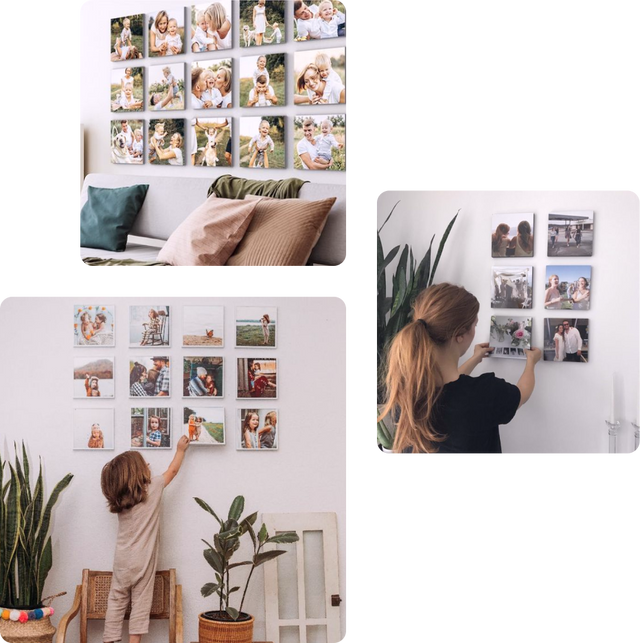





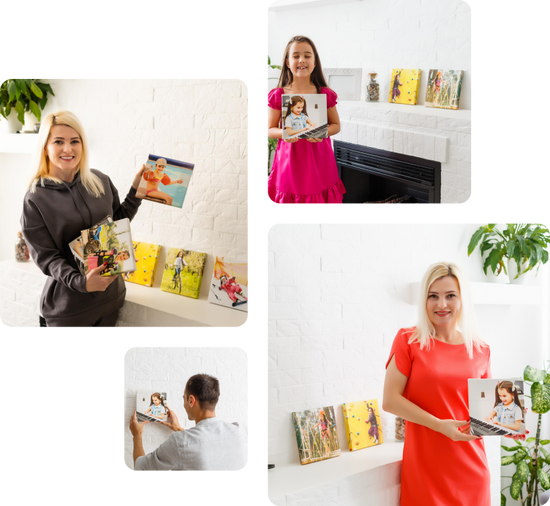

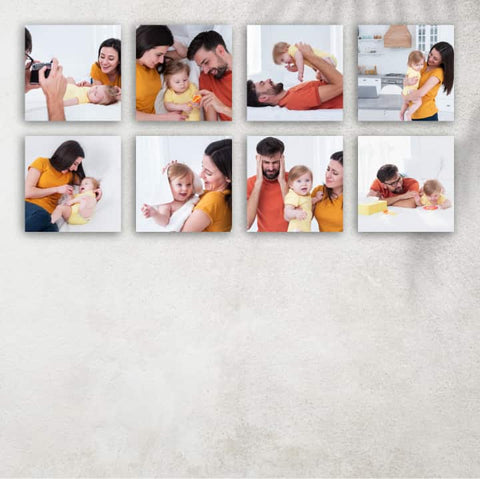
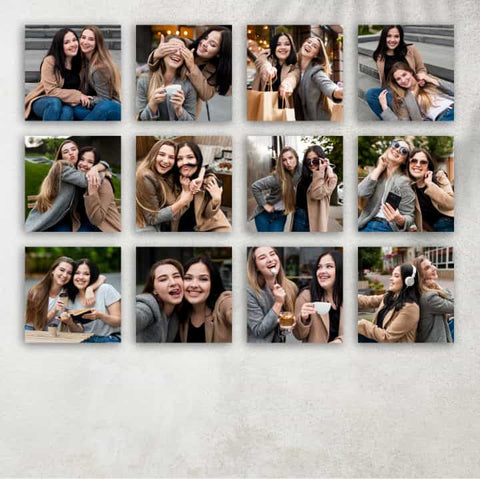

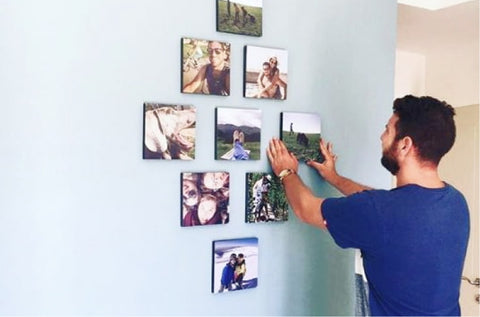
 (4.9/5)
(4.9/5)
